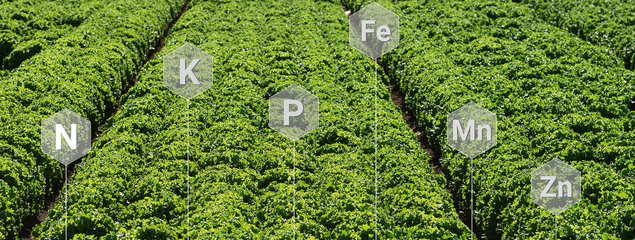
Improve Plant Nutrition
Fertilizer Guidelines for Vegetable Crops in Arizona
Crop Fertilizer Guidelines (3)
Lettuce Fertilization (3.1)
The total amount of in-plant accumulation of nitrogen (N), by lettuce crop is typically less than 160 lbs of N/acre, and the amounts removed at harvest are typically less than 100 lbs of N/acre (Table 3-1-1). Both above ground N accumulation and N harvest removal vary with lettuce type. However, N removal at harvest also depends on trim level within the lettuce type. For example, wrapped iceberg is trimmed more than a naked pack, and romaine hearts are trimmed more than regular romaine.
Data collected in the Yuma area show all full-season lettuce types, regardless of morphology, biomass production, and N accumulation, show a similar response to N fertilization (Figure 3-1-1 and Table 3-1-2). Thus, recommended N fertilizer requirements are the same for all the full-season lettuce crops grown in the region (i.e., full-season iceberg, romaine, leaf, Boston, and bibb lettuce). Fertilization guidelines for baby lettuce are addressed in Section 3.5 under the heading baby spinach and lettuce. The N fertilizer rate required for optimal yield varies with soil test nitrate-N levels, but it is generally less than 200 lbs of N/acre (7, 14).
Lettuce N uptake through thinning and cultivation is less than 10 lb/acre, but often some early season N may be required if pre-plant soil test nitrate-N is less than 10 ppm. Monoammonium phosphate (MAP or 11-52-0), is the most common P fertilizer source used for vegetable production in Arizona. Since MAP contains N, the N early season requirements of lettuce through this period are often met with pre-plant P applications. However, if pre-plant MAP application is low due to high soil test P levels, supplemental early season N fertilizer application may be required (see Table 2-1-1, Section 2.1). About 10-40 lbs of N/acre can be applied through pre-plant broadcast or sprinkler fertigation for the period spanning germination and emergence.
For most vegetables produced in Arizona, the main seasonal N fertilizer application is made immediately after thinning and during cultivation operations. Current guidelines call for side dress N fertilization when soil nitrate-N test levels are less than 30 ppm. The required application rate depends on the difference between the minimum required threshold of 30 ppm and the soil test level. Approximately 4 lbs of N/acre needs to be added to increase the soil test nitrate-N by 1 ppm. As noted in Section 1, there is no significant difference in crop response to different N sources applied through side dressing. As a result, growers typically use UAN-32 as a soluble N fertilizer source among available alternatives, mainly based on economic considerations.
In Arizona, there are small acreages of drip irrigated lettuce. Because of the high irrigation frequency characteristic of drip irrigation systems, fertigation under drip systems allows for better matching of N fertilizer applications with crop N requirements through the season. The guidelines for the application of N fertilizer to vegetable crops through fertigation under drip irrigation systems are summarized in Section 4.3.
Lettuce consistently shows response to P fertilization for soil P levels up to 35 ppm Olsen P. All full-season lettuce types show a similar response to P fertilization (80, 81). However, even at soil test levels above 35 ppm, lettuce may respond to a small starter fertilizer injected near the seed, especially during the cooler growth periods (Figures 3-1-2 and 3-1-3). The data shown in Table 3-1-2 are for broadcast and disk pre-plant applications. If the P fertilizer is applied in bands near the seed or strip applied in beds, the rate can be reduced by 25-35% (Section 2.2).
No lettuce crop response has been observed to K fertilization in Arizona. Nonetheless, it is prudent to occasionally run a soil test for K to verify that AA K levels are greater than a minimum threshold of 150 ppm (Section 2.3) and conduct occasional tests of lettuce leaves to verify that K concentrations are above 4% (Section 4.3).
The only other nutrient that may occasionally be needed for lettuce production in Arizona is zinc (Zn). The Zn fertilizer guidelines, which were developed based on DTPA soil tests, are summarized in Section 2.5 and are applicable to all vegetable crops grown in the region. Lettuce leaf tissue analysis can also be used to monitor plant Zn levels and values under 35 ppm might indicate the need for Zn fertilization (Section 4.3).
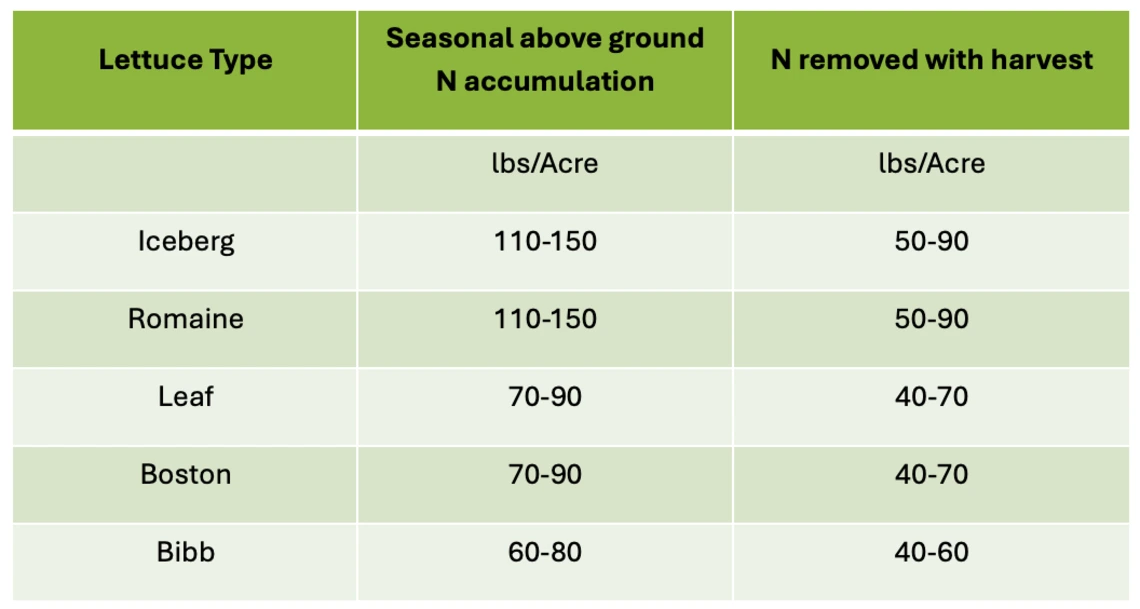
Table 3-1-1
Ranges of total accumulation of N in above ground crop and N removal with harvest
Adapted from several sources (7,11, 12, 13,14, 79).
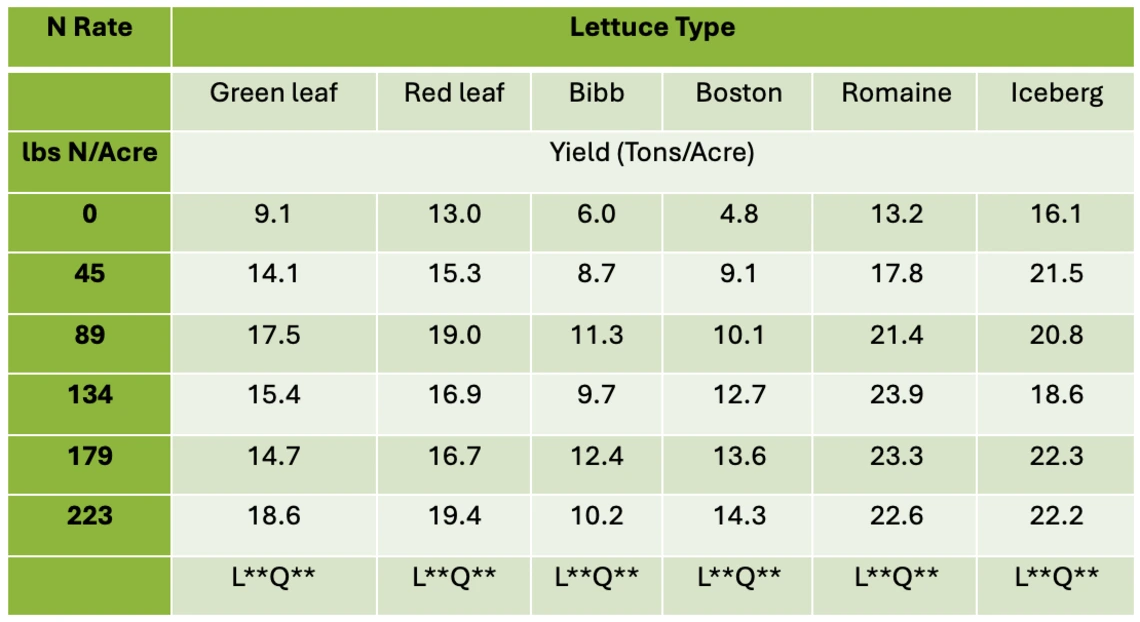
Table 3-1-2
Response of different lettuce types to N fertilizer in Arizona.
Data are means from three seasons of field experiments conducted in the Yuma Valley. All lettuce types were subplots within N rate main plots. Although lettuce types vary phrenologically and in biomass production, the N rate by cultivar interactions were not statistically significant and suggest all lettuce types showed a similar curvilinear response to N.
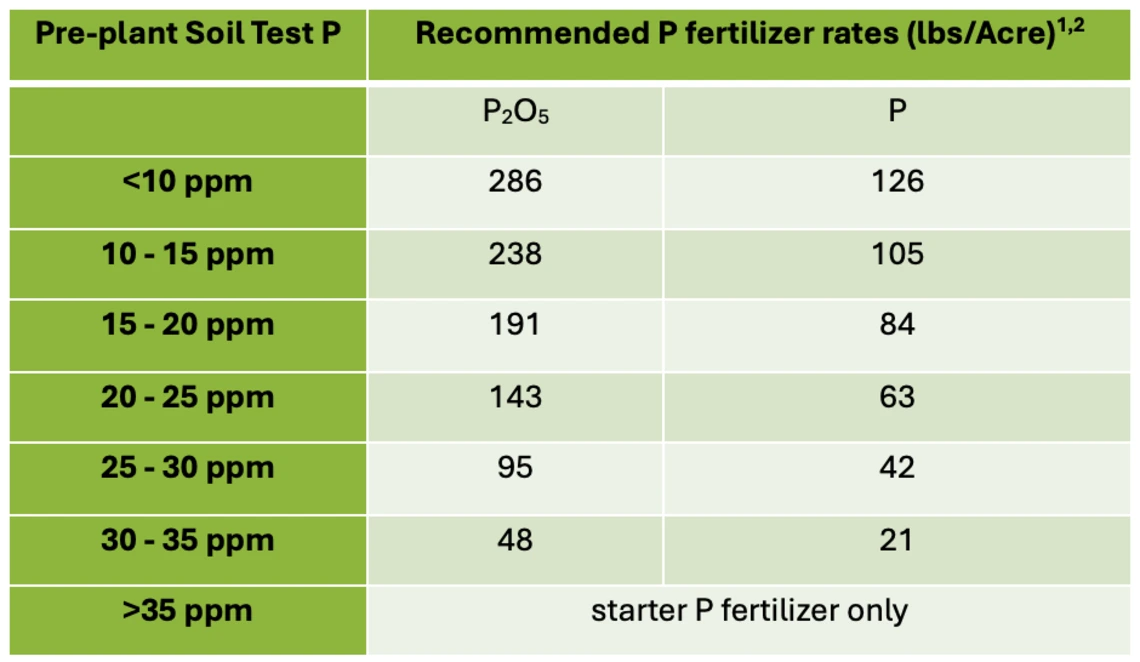
Table 3-1-3
Lettuce P fertilizer guidelines by pre-plant Olsen P soil test.
1 The fertilizer label is in %P2O5 , and recommendations are made as P2O5. However, we have expressed the rate as P (44% P2O5) for data presented, and the recommended rates in this convention are shown as well.
2Approximately 35% less P fertilizer can be used when it is band applied, or 25% less if it is applied in strips.
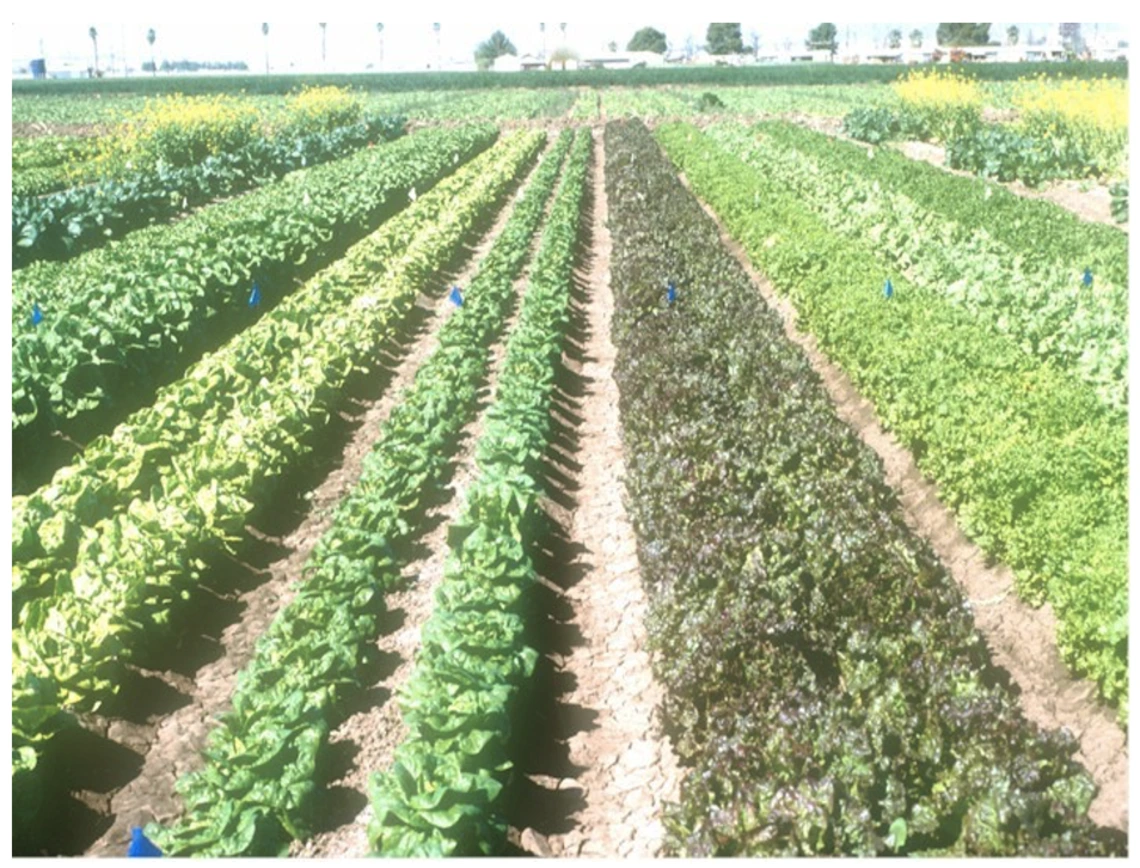
Figure 3-1-1
Studies conducted at the Yuma Agricultural Center to evaluate the relative response of lettuce and other leafy vegetables to N fertilizers.
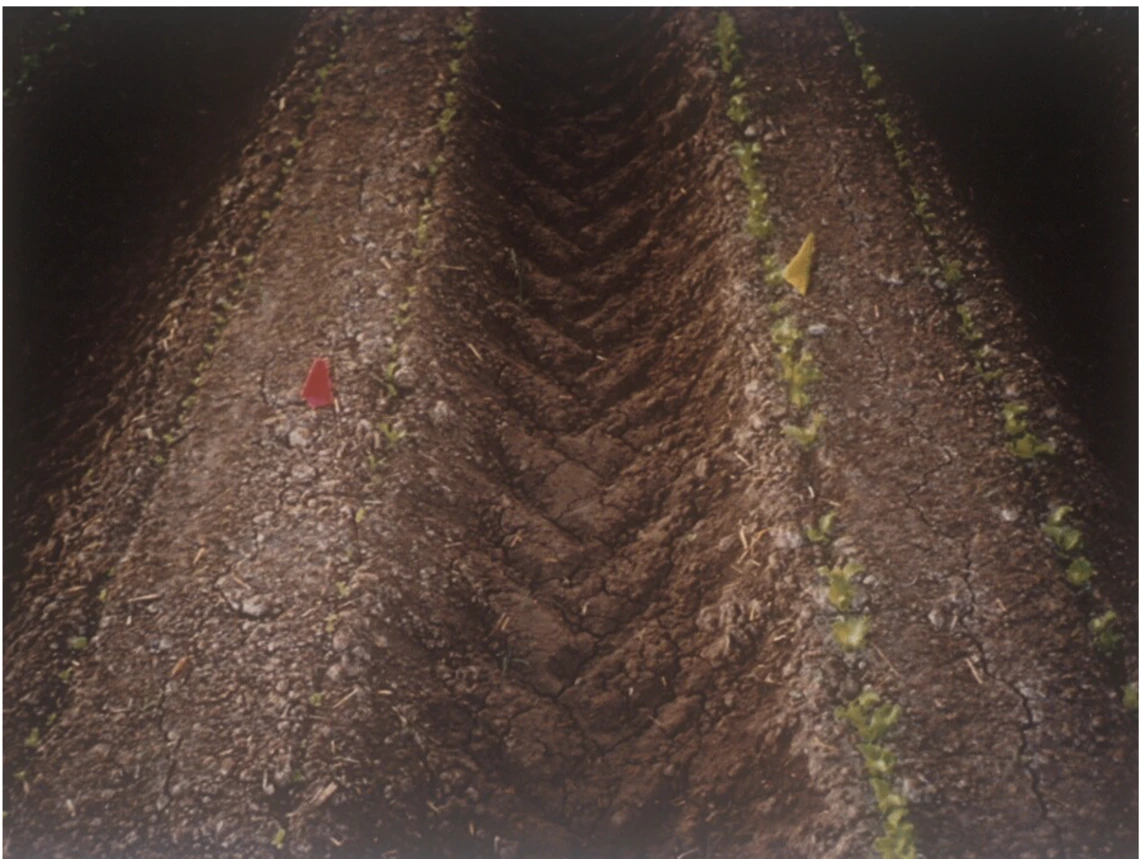
Figure 3-1-2
The bed on the right shows early growth to starter P fertilizer (7.5-26-0) versus the bed on left that did not have starter P fertilizer.
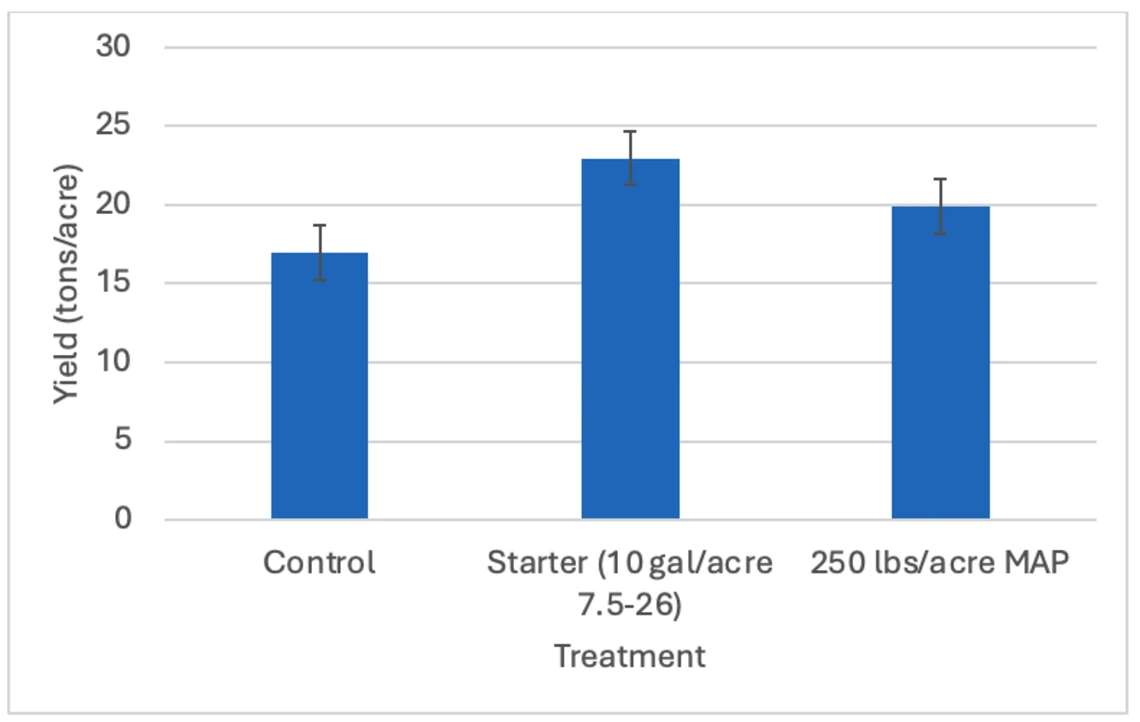
Figure 3-1-3
Response of lettuce to starter P fertilizer, or broadcast MAP, when pre-plant Olsen P was >30 ppm. Data are means of 10 grower sites.

